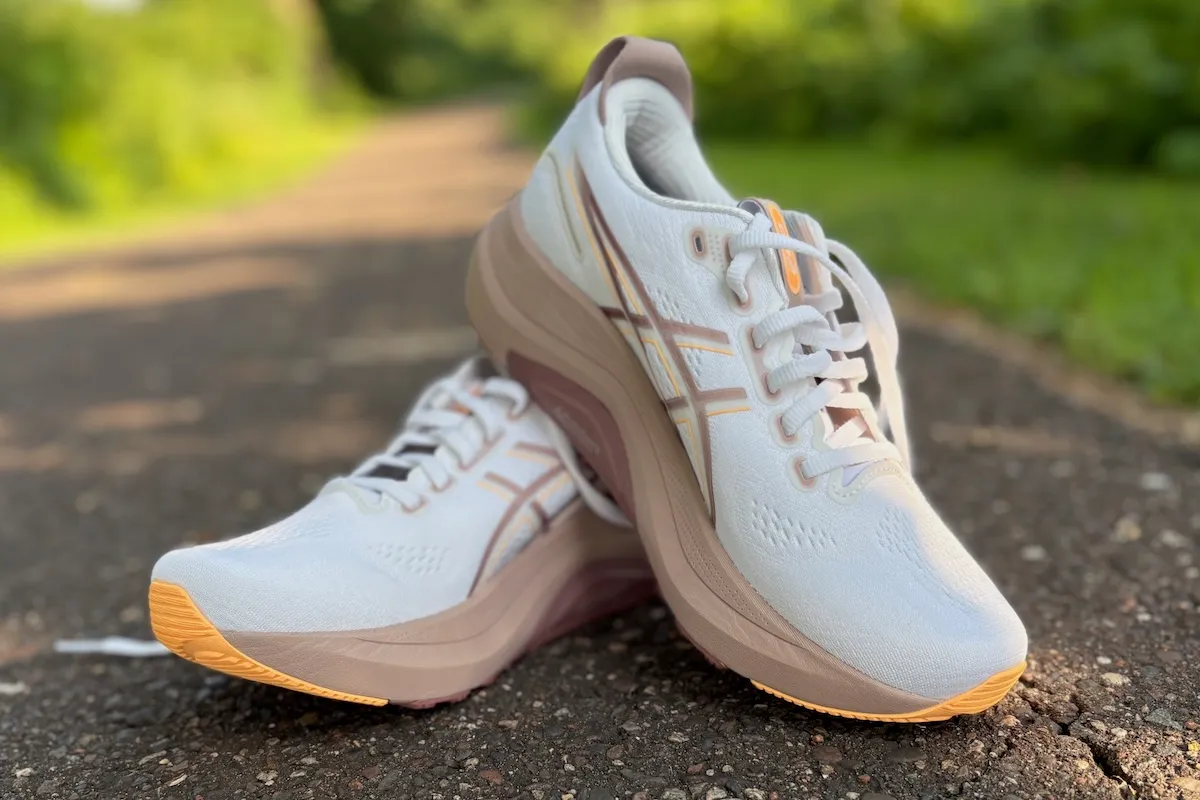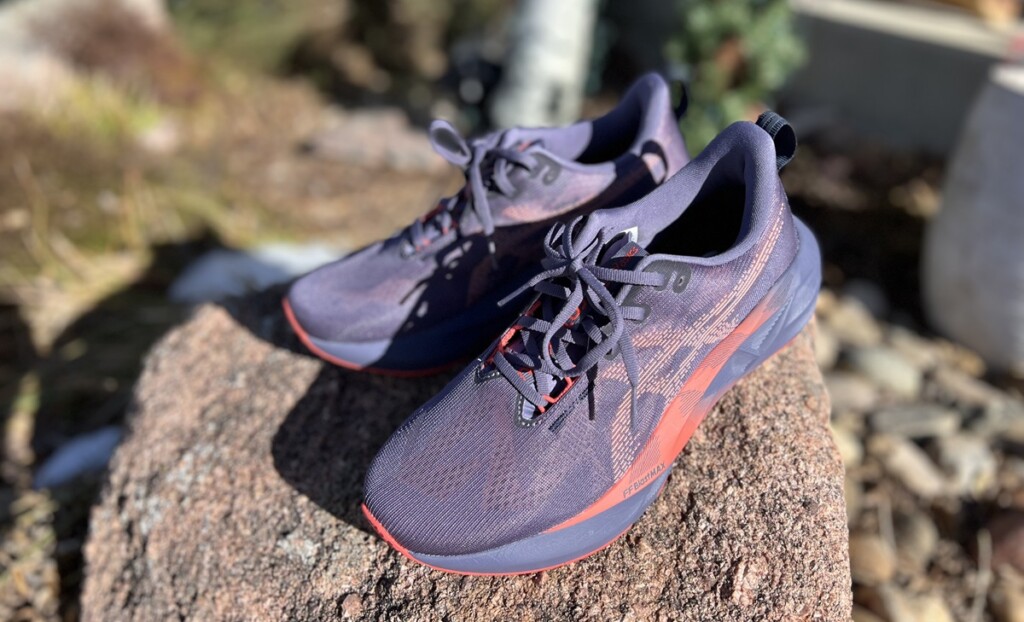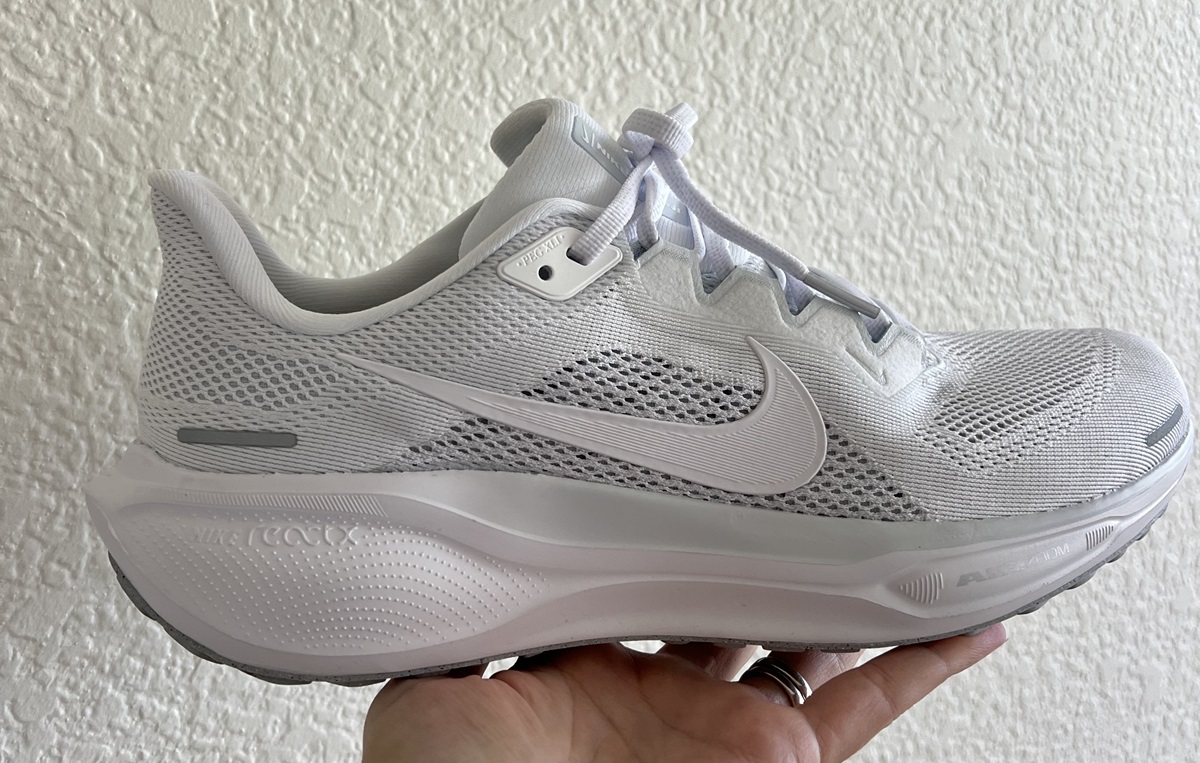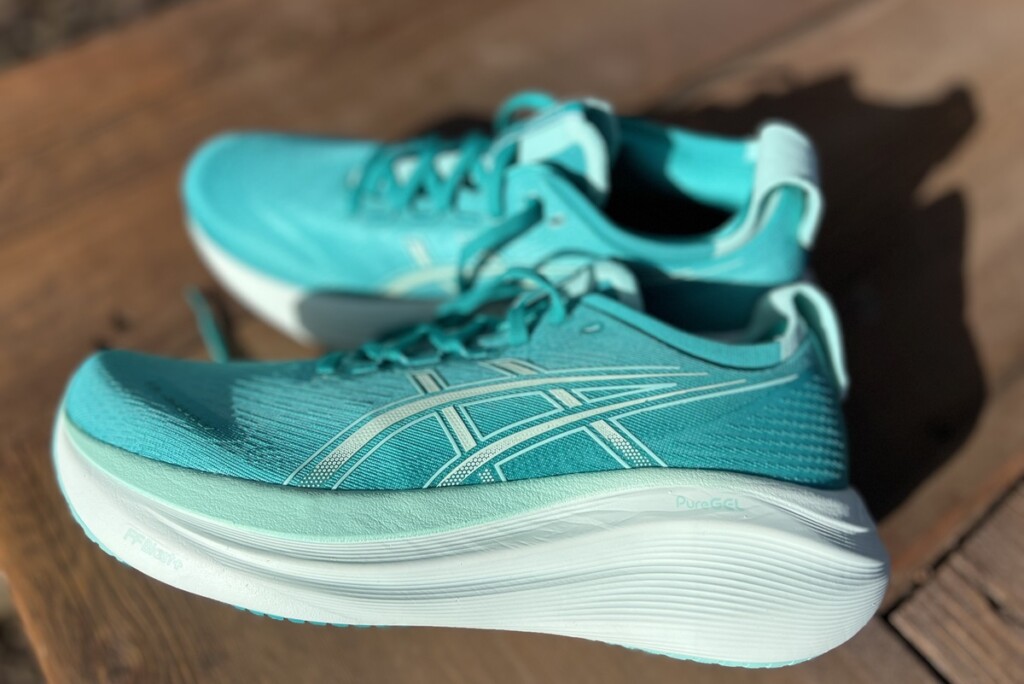Comparing Nike vs ASICS running shoes could largely be described as a difference in fit and feel, along with some company philosophy if you care about those things (which a lot of you do in this case). Nike might be a behemoth in the sports world, but ASICS is no slouch. Let’s find your perfect shoe.
ASICS is well known for their sponsorship of many large marathons and long partnerships with athletes like Deena Kastor.
In the last 20+ years of running and writing shoe reviews, I’m happy to say that I’ve run in a WIDE range of shoes from both brands. There are models I hated, ones I loved and a bunch in between that were just fine, but not my perfect shoe.
Both brands provide high quality shoes and offer a variety of models to suit different needs like overpronation, cushioning, and trail running.
Today, I’m going to give you a breakdown with an overview of features and then we will compare shoe models side by side.
Nike Vs ASICS Key Differences
Asics and Nike offer similar features and models for all kinds of runners, from the new runner to Ultramarathoner to the flat-footed or high-arched.
Largely we’re looking at how a maximal shoes compares to a traditional running shoe.
I break down the differences in more detail below, but here’s a quick overview:
Nike Running Shoes
- More narrow fit, especially in the heel and midsole
- Tend to run smaller in width and length than many other brands
- A larger focus on newest and trendiest technology to “improve running economy”
- Known across a wide variety of sports and highly visible in competition
- Loves to be high fashion
- Has a large brand loyal following
ASICS Running Shoes
- More narrow fit, especially in the heel and midsole
- Famous for its GEL technology, which provides shock absorption
- Seems focused on shoes to prevent injury
- Designs a variety of shoes for many different sports
I’ve worn both brands and will add some personal thoughts, along with links to detailed reviews.
If you’re looking for other comparisons, checkout ASICS Vs Mizuno or Hoka vs On Cloud or Hoka Vs Saucony.
ASICS vs Nike Feature Comparison
Both brands have been around for so long they have model numbers in the 40’s, which means it’s often hard to get runners to switch from a beloved shoe. But if you’re new to them and trying to make a choice, hopefully this helps.
Both offer options to aid with comfort, support, stability, and cushion. Where they differ most are in the feel and fit of the shoe while running.
The following breaks down each shoe based on the components buyers need to consider when purchasing a running shoe.
It’s gonna get a little TECHY…so you can just skip on down to the specific model comparison if you want, but personally if I’m shelling out $150 for shoes, I kinda want to know why.
Durability
The lifespan of shoes from both companies is fairly comparable.
- ASICS recommends swapping out for new shoes every 450 to 500 miles.
- Nike’s Vapor Fly is only going to give you about 200 miles, but most shoes are in the 300-500 mile range. (I will say some of my favorite Nike’s are definitely on the lower end of lifespan compared to other shoes.)
Determining when to replace running shoes, of course, all depends on your gait, weight, and whether you run mostly on trail or road.
Shoe Fit
ASICS shoes have a more snug fit, particularly in the heel and midfoot. Though still not as narrow as Nike. An external heel clutch delivers targeted fit and support, while the Gel technology allows for foot movement in various directions as the foot transitions, reducing heel strike.
While ASICS also features a shoe fit guide, it takes a little sleuthing to find (you’re welcome).
Nike running shoes are often reported to run small. I would say this is hit or miss for me. Some shoes seem totally fine and others, I absolutely wish I had a half size up. No rhyme or reason to which shoe I notice it most in.
They do not offer the variety of widths that you’ll see with New Balance. But if you like the fit, you’ll find it fairly consistent across models.
Cushioning
ASICS uses Flytefoam technology that provides bounceback and responsiveness with each step. It gives a bit less energy return than say Brooks shoes, but the two technologies are fairly similar.
The company has been using their famous Gel technology for more than 30 years. It works well to absorb the shock with each step.
Nike started putting air in their shoes back in 1977 to improve cushioning.
“Nike Air technology consists of pressurized air inside a tough yet flexible bag and provides more spring without compromising the structure.”
And since the 90’s they’ve been recycling waste material from production in to new shoes. They continue to look at this sustainability in developing new shoes.
However now, their big thing is ZOOMX foam. I wrote about it in-depth on the Nike Invincible review.
Nike ZoomX cushioning is Nike’s latest innovation in running technology.
It’s a cushioning system that provides lightweight, responsive cushioning for a faster and more comfortable ride.
Made from a unique foam material that is 30% lighter than traditional foam and is designed to provide maximum energy return, allowing runners to go farther and faster. The foam also provides a softer landing and smoother transitions from heel to toe.
Stability
ASICS shoes provide stability through a dual density midsole system called Duomax, which enhances support and stability. That, along with the external heel clutch allow the foot to continue its natural movement while running.
Nike does say their stability shoes are slightly wider and also designed with a curve that will help with heel to toe transitions.
As you may know, I’m not a huge fan of stability shoes for most runners. I am not finding a big difference in brands, they are all focused on preventing that foot roll and often feel a little stiffer

Overview of heel to toe drop and type of cushion in most shoe brands.
Affordability
The prices between the two brands are fairly comparable.
- ASICS prices range between $110 to $160
- Nike start at $120 to $180
Specialty items with more features (like carbon plates) will increase price.
You’ll notice that every brand offers a range and this is indeed due to a difference in technology and where they sell the shoe. They know that the big box store can sell the shoe with less in it, while the local running store needs to be best for dedicated runners.
Nike Vs ASICS Running Shoes
Now that you know more about each brand, let’s look at their top models in each of the main categories. There’s no winner declared here because all are great shoes, it’s just about which one is best for your foot.
With each of these, they are the top models so numbers are constantly changing as they make a little upgrade.
Quick note, I absolutely encourage you to checkout Nike’s return policy! It makes it much easier to test out a shoe and return if it doesn’t feel right.
Stability Running Shoe
👉ASICS GEL Kayano
The GEL Kayano is now in its 32nd iteration and known as one of the best stability shoes on the market. Great for overpronators seeking stability, the GEL Kayano is an ideal shoe for marathons.
It’s more cushioned than most stability shoes and thus has remained a favorite of many runners for a very long time. To be clear, it’s not that plush max cushion feel, but a moderate underfoot feel that allows for pronation correction.

The fit is in line with most shoes, but you will notice a bit more of a heel lock. This is again to help with that foot pronation without over correcting.
- Weight: 10.7 oz Men’s, 9.1 oz Women’s
- Stack Height: 40 mm
- Heel Drop: 8 mm
- Available in nine colors
- Available in wide and narrow
- Available at Asics.com for $165.00
- Read our full review of the Asics Gel-Kayano 32 here >>
👉React Air Zoom Winflow 9
Another shoe utilizing their great react cushion and the wrap around feel of the flyknit upper.
It has a slightly higher arch and more room in the toebox than most Nike running shoes.
This is what they call a stability neutral shoe, which is probably more in line with what I’d recommend. It’s not a firm and will not be over correcting your foot strike. It has guiderails as most stability shoes do, but without losing the softness.
- 10mm drop
- 10 oz women’s, 9.9 oz men’s
- $100

I couldn’t finish the stability shoe section without mentioning the newer style that Nike has started promoting. The Nike Invincible!
I recently tested version 3 and I’ve honestly never found a stability shoe with so much bounce. It’s definitely benefiting from using the same foam as the Vaporfly racing shoes.
While the shoe is still narrow, per normal Nike, it has a much wider base and therefore offers a lot of stability with that cushion. Plus an outsole with grip for going from road to trail.
Neutral Running Shoe
👉Asics Novablast 5
The Novablast has been a winning max cushion shoe from Asics since it first launched and they have continued to increase the amount of cushion in the shoe, while working to drop the weight. It’s not going to be the plush shoe you’ll see below, but it’s a great amount of cushion in a weight that’s going to translate to a lot of miles for the average runner from training even to race day.
The 5 has a completely new full length midsole with their FF Blast Max foam. Again, I like that this shoe is a more responsive cushion and you don’t sink in to it so much.
While this is a neutral shoe, with no guiderails or anything for stability, it absolutely has some of that built in to the design. The width of the platform from toe to heel reduces pronation and provides a really good ride.
- Heel toe drop: 8mm
- Weight: 7.9 oz women’s, 9.1 oz men’s
- Stack Height: 41.5mm
- Read my full review of the Asics Novablast 5 >>
- Available at RunningWarehouse.com $160 (my favorite for easy returns) and on Asics.com
👉 Nike Pegasus 41
The Nike Pegasus has all the bells and whistles that a runner could ask for: just the right amount of cushion in midsole for maximum comfort, durable rubber outsole to withstand, and a breathable mesh upper to keep your feet feeling fresh and dry.
But let’s get real for a second. The Nike Pegasus isn’t just a pretty shoe. It’s got substance too, with a firm heel counter that keeps your foot locked in place and a molded foam insole that provides extra support for those long runs.
This is a good option for your easy weekday runs or for the support of a marathon training run.
This is definitely a shoe that I like for those weekday training runs. Not over built, just enough cushion and a little roomier than other Nike’s.
- Heel drop: 10mm
- Weight: 10.4 oz men’s, 8.6 oz women’s
- Available in 14 (!!) colors
- Available in Extra Wide
- Available as a trail shoe as well
- Find it here on Nike.com for $140, so you can enjoy their 30 day trial policy!
- Check out our full review of the Nike Pegasus 41 here >>

Cushioned Running Shoe
👉ASICS GEL Nimbus
This shoe will appeal to most runners looking for a neutral fit and some MAX Cushion.
This is the plushest shoe in their line up with a great big old stack height and we’re here for it. The most recent model feels like a great update to a shoe that will carry a lot of runners over long miles with foam that’s durable and a fit that isn’t overly soft.
 With the 42mm stack height, they did manage to retain a feeling of stability. The firmness that I wasn’t a huge fan of with the last one (because why should a max shoe feel firm) is gone and now it’s just a big cushioned ride. For me personally, I can’t say it’s a shoe I’d wear for anything other than easy runs. I certainly wouldn’t turn to it for tempo work or a race where a PR is the goal.
With the 42mm stack height, they did manage to retain a feeling of stability. The firmness that I wasn’t a huge fan of with the last one (because why should a max shoe feel firm) is gone and now it’s just a big cushioned ride. For me personally, I can’t say it’s a shoe I’d wear for anything other than easy runs. I certainly wouldn’t turn to it for tempo work or a race where a PR is the goal.
- Heel toe drop: 8mm
- Weight: 9.2 oz women’s, 10.7 oz men’s
- Available at Asics.com and RunningWarehouse.com $165
- Read our full review of the Nimbus
👉React Infinity Run V 3
Another shoe utilizing their great react cushion and the wrap around feel of the flyknit upper. It’s super similar to the Epic React that I loved running in for many years, except it’s a stability shoe.
It has a slightly higher arch and more room in the toebox than most Nike running shoes.
This is what they call a stability neutral shoe, which is probably more in line with what I’d recommend. It’s not a firm and will not be over correcting your foot strike. It has guiderails as most stability shoes do, but without losing the softness.
- 8mm drop
- 9.2 oz women’s, 10.7 oz men’s
- $165

Carbon Fiber Plate Shoes
Are they cool new technology, yes.
Do they last as long as your other shoes, nope.
So if you want to test these out use them for speed work and then race day!
👉Nike ZoomX VaporFly 3
Similar to the AdiPro this is another max cushioned carbon fiber plate. For me it just makes the shoe more accessible to the everyday runner who enjoys cushion. Though maybe at $250 accessible is the wrong word?!
This is one of the lightest shoes with cushion I’ve seen. This absolutely matters over the course of 26.2 miles where every second adds up to hit or miss your PR.
You will absolutely feel the bounce in this shoe, it’s dreamy. While the debate rages on who will benefit, I can say in my tests that I found my HR lower and thus was able to run faster.
- 8mm drop
- 5.8 oz women’s, 6.6 oz men’s
- $250
Read my full review of the Nike Vaporfly (hint…I love it).
And more importantly a comparison of the Nike Alphafly vs Vaporfly. Which is the right race shoe for you?

👉ASICS Metaspeed Sky
ASICS is trying to catch up in this area and released a few shoes all at once which many folks can’t quit tell apart. The Edge is going to be the shoe with less cushion, less weight and better for those racing sub 3, etc.
This is a maximum cushioned carbon fiber plate for the marathon runner in you. It’s going to give you both that feeling of comfort over the miles along with the pop that’s often lost in a highly cushioned shoe.

- Unisex in the SKY+
- 5 mm heel drop
- 5.8 oz women’s SKY, 7.2 oz SKY+
- $250
Watch my detailed video on how Carbon Fiber Shoes work.
How to Choose ASICS or Nike Running Shoes?
Now that we’ve gone through the different models, you have a better feeling for what sets each apart. I can’t recommend enough that you buy knowing you can take them out for a few runs and return.
Seriously, return policies are pretty amazing.
And remember: Your gait and feet will likely change over time and you may need to change shoes.
This is also why I recommend rotating through several pairs of shoes at once.
Keep in mind that shoe design can change, even with the same model, so always assess how the shoe fits every time you replace a pair.
For more help selecting the right shoe for you, don’t worry, I’ve got you:
- Nike Vs New Balance running shoes
- Altra Running Shoes Review
- Top 5 Marathon Running Shoes
- New Balance Vs Brooks
- Best HOKA Running Shoes
Other ways to connect with Amanda
Instagram Daily Fun: RunToTheFinish
Facebook Community Chatter: RunToTheFinish
Sign Up to Receive a Weekly Newsletter with Top Running Tips and Laughs



 What’s the Fuss about Peak Week Marathon Training?
What’s the Fuss about Peak Week Marathon Training?